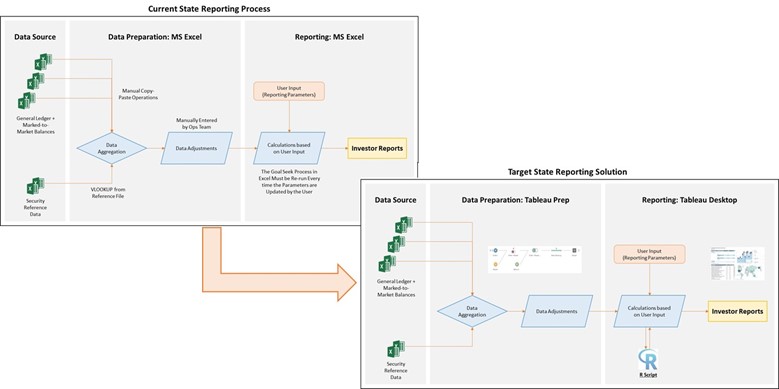Nearly 90% of the world’s data has been created in the last two years. In today’s digital age, companies are at the forefront of the data revolution, but they are also required to adapt to meet ever-changing demands.
The need to manage and report larger volumes of data raises the requirement for a robust preparation and reporting solution. All companies will eventually be faced with the question that business leaders must ask themselves: Is it finally time to move away from Excel?
The answer to that question lies in the answers to a few others:
- How large is the volume of our current data?
- How fast do we expect to grow in the near and distant future?
- Does our reporting infrastructure need to transition to an automated future state?
- Can we free up resources to perform more critical functions?
Many organizations are finding their current state reporting solution to be a repetitive process that involves such tasks as manually copying data from source systems into an Excel workbook, applying certain manual adjustments to the data, and using native Excel calculations to produce reporting metrics. This process is similar to what many other companies are currently challenged with, leading to certain shortcomings:
- Manual and laborious data processing;
- Repetitive low-value tasks;
- Limited scalability; and
- Prone to human error.
In order to mitigate these issues, it is possible to design a solution that would automate the querying of data from source systems, perform data aggregation and necessary calculations, and create presentation-ready reports, such as by integrating an R Programming script with Tableau. These tools are well suited for solving the problem of manual, repetitive, and error-prone processes that follow a rule-based structure.
The exhibit below presents a comparison of the current state reporting process with the target state solution.

Here, the reporting solution sits on top of Excel; most of the datasets were already maintained in spreadsheets, information from other sources (such as MS Access) is manually queried into Excel, and the reporting solution picks up data from the different Excel spreadsheets.
By using Tableau Prep, an industry leader, as an ETL (Extract, Transform and Load) tool, data is queried from multiple Excel spreadsheets and aggregated using a custom-made workflow tailored for the company’s process. The introduction of an ETL tool takes away the manual aspect of data aggregation, thereby reducing processing time and eliminating human error. Tableau Desktop, employed as the reporting tool, then makes use of filters and parameters to introduce user interactivity and increase accessibility.
The creation of reports and automation of certain calculations that were being performed manually frees up resources to perform more essential functions, such as understanding the outputs on the report and spending time developing key business strategies.
One major hurdle that can be faced during the design process is the calculation of certain reporting metrics that cannot be performed using native Tableau operations. As a workaround, Tableau’s R Programming integration can be leveraged, enabling you to calculate some of the more complex metrics. As opposed to applications such as Excel, R is an open-source language that allows users to continually build upon it, as well as stay up to date with upcoming trends, and allows for greater flexibility.
Is this the end of the development cycle for the reporting solution? Certainly not. We recommend setting up a data warehouse to capture and store all transactional data. As an organization grows, managing data across multiple Excel spreadsheets is not only cumbersome, but prone to error. GL platforms will maintain a trail of data that enable business users to trace business operations back to financial reporting on a continual basis.
A key benefit of Tableau based reporting solutions is the versatility of data sources. Although the current solution sits on top of Excel, you can directly query data from other data sources (such as a GL) by making just a few updates. No need to reinvent the wheel from scratch!
So, what will tomorrow bring for your reporting process and business needs? The answer to that depends on where you stand today, and where you see yourself and your company in the near and distant future. While not all companies are ready and able to embrace the data revolution, the time will eventually come for business leaders to ask, “Is now the time to move away from Excel?” When the question is asked, it is time to create the solutions required to succeed as you plan for the future.